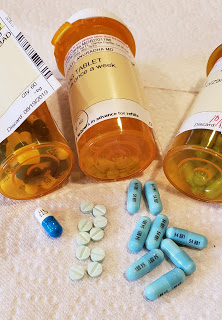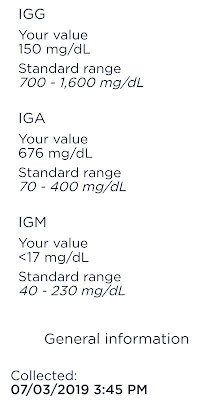Hellllloooooo July!
And to think where I was, and what I was enduring... 9 years ago this entire month...
But back to my future...
I'm feeling so lucky... so surprised this current weekly cocktail of 40mg Dex Steroids, 1 Velcade subQ injection, and 800mg of Cytoxan, Cyclophosphamide (8 pills @ 50mg each) is still pummeling my "aggressive, high risk" IGA myeloma. I read and hear about so many suffering, so many where treatments are not working, or work then fail quickly, or the side effects are just too much too tolerate. But then there are those that do tolerate the meds just fine, with minimal side effects. Crazy how myeloma morphs and mutates and transforms so differently for all of us. As I write this, my mouth tastes like dirty metal, my stomach hurts, my head hurts, my skin aches, I feel swollen, my eyes are blurry, neuropathy numbs my extremities, and the fatigue is exhausting, but I am ever so grateful to still be here to take these powerful fighting meds that are keeping me alive, one day at time, one month at a time.
My monthly Dr appointment was originally for this past Monday, but my Dr had a change in her schedule, so I was rescheduled for today, Wednesday. I pull myself together, "fake til I make it", to get there today. Otherwise I would not be leaving the house.... I requested to maintain my regular Monday chemo schedule tho, as I didn't want to change my to Wednesdays. "If it ain't broke, don't fix it or change it", right! So I slammed down my triplet cocktail on Monday, but why I feel so lousy today :((
But in all of this insanity, 9 and a half years of treatment insanity, and who knows how many years prior of actual myeloma invasion, I'm here to still tell my story, and live my life in a limited, but still pretty awesome way.... well to a degree... sometimes...
So take a look at my crazy lab results. Still quite Abnormal, but I'll take it, compared to previous labs where I was 5x, 10x times the High End of Normal!!!!
Hoping you're well, staying strong, fighting your fight, and enjoying what gives you joy!
Thank you for checking in and caring about my myeloma journey. I still feel I am telling someone else's story... how can this be my life... along with my husband's sad Alzheimer's decline... how did we both wind up with incurable, life altering, life disabling illnesses, that stole our lives individually and as a couple... so cruel... so mind bending... yet trust me... I ALWAYS COUNT OUR BLESSINGS and good times...










So glad your numbers are getting better. Sorry for all the side effects. But we take what we get to be able to keep MM at bay as best as we can. Love reading your blogs. Jewell
ReplyDeleteHi Jewell, thanks so much for checking in :)) Yes, this triplet cocktail is doing it's thing. I feel so lucky to have been able to stay on this treatment for the amount of time I have been. Hoping you are doing well and feeling well. What treatment are you currently on? Thank you for appreciating my posts xoxo
Delete